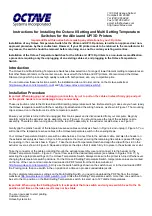
XPM 80™
Thermal Printer Family
HENGSTLER
Part No. D 690 019
Mod. No. 4 051015 Eli1
page 8 of 32
3. Overview
3.1. Overview of Thermal Printing Technology
A brief overview of thermal printer technology might be helpful to understand how the XPM
80™ thermal printer family works. In most direct thermal printers, paper is fed over a soft,
rotating platen and under the thermal printhead. The platen acts as a roller to advance the
paper, and at the same time acts as a surface against which the spring-loaded printhead
presses the paper to insure good thermal conductivity. Circuitry in the printer determines
which heating elements to activate (“fire” or “burn”) to form the next row of dots on the paper.
The thermal paper is coated with several compounds. At room temperature, these
compounds are white in color and do not react with each other. The heat from the thermal
printhead acts as a catalyst in the areas where the small printhead dots are fired, causing
these compounds to react with each other and form a new compound which is a contrasting
color, usually black. The platen then advances the paper to the position of the next dot row,
and the process is repeated.
You may note immediately several of the advantages of thermal printing. First, since the
printing is done with heat, there is no noise from the printing process itself. Thermal printing
is inherently quiet compared to most other technologies, such as impact dot matrix. Also,
there is only one moving element in the thermal printer: the platen. This provides increased
reliability and life when compared to other technologies. Since the chemistry of the thermal
paper itself is what causes the printing to appear, there is no replenishment of ink ribbon, ink
cartridges or toner. This makes thermal printing the least maintenance-intensive of all
common printer technologies.









































